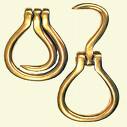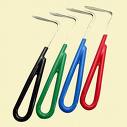How to Pick Out A Horse Hoof
by Debora Johnson
 It seems like this should be a very easy thing to do--picking out your horse's hoof! Sometimes, your horse may not want to comply. So, below are some suggestions as to how you can train your horse to be a sweetie when you are picking out his hooves. I have trained my horse, A Patchy, to pick up each foot for me without even touching him. However, I always have contact with a hand on my horses, when working around them. That lets them know where I am at all times. Also, when I walk around any horse's hind end, I stay very close to the tail and hind legs (even against the rump) so that the horse knows exactly where I am. It is very difficult for them to kick you if you are up against them. It is very difficult for them to get those hind legs in a kicking posture. I stand beside the left (near) front hoof and point to it. I say A Patchy "Hup, hup," and he whips it up and holds it for me. I gently cup the hoof in one hand, pick out the hoof with the other, and apply Keratex. Then I proceed around A Patchy to the near back, far back, far front. Done! "Good boy!" One more really important tip. If your horse is tied in any way, do not duck under the rope. If your horse pulls a surprise you can get tangled up in the rope and be in a very bad circumstance! Dangerous.
- Put your horse in cross ties to train or have another person hold him by a lead rope attached to his/her halter.
- Have a calm environment--no distractions while training.
- Pet your horse and speak sweetly. Continue when your horse is relaxed.
- Start, always on the front, left (near) side and then continue to near back, far back, far front when picking.
- Be consistent.
- Face his tail while you are standing at his near shoulder.
- Make sure that you are well balanced in case your horse makes a sudden move or misbehaves. Remember, they weight a lot!
- Make sure that your feet are away from your horse's so that your feet will not be stomped!
- Make sure that your horse is squared. That is, balanced evenly on all fours with his feet properly placed.
- Gently run your hand down your horse's front leg.
- At the fetlock squeeze gently with your thumb and pointer finger and give a command of some sort, but be consistent. As I said above, I say "Hup." You say whatever pleases you.
- If your horse doesn't get it--and does not pick up his foot. You can lean gently into his shoulder and offset his balance to the other side. This allows the foot to be picked up.
- When the foot is picked up give lots of praise and positive reinforcement.
- When the foot is up visually check to make sure there are not any cuts, bruises, punctures or foreign objects in the underside of the foot. Look for cracks in the hoof walls or anything that is unusual.
- Pick out the foot, but always start from the heel and go to the toe. The pick can be a dangerous instrument, believe it or not, if used improperly. I use a hoof pick that has a small wire brush on the end of it, a solid handle, and strong pick. The picking part is made out of metal, not plastic. I brush off the hoof first, then proceed to pick.
- I have been told that if a horse refuses to pick up his foot that squeezing the chestnuts is an incentive to the horse. I do not know why, and have never had to do this.
- If you have patience, most horses will usually catch on pretty fast. Most horses want to please.
- I have found that if a horse refuses to pick up a foot on a regular basis there is probably a reason. Pain or discomfort is usually it.
- In this case further investigation should be done to determine what hurts
When picking, remember that the frog, the "V" shaped area is sensitive. It has a blood supply and nerve endings. It is NOT horn. I use the brush on the frog or my fingers--not the pointed pick.
- The frog has a regular shedding cycle. You may want to discuss this with your farrier to learn more about it. Do not be alarmed if you notice that the frog is flaking off.
- There is a white line that you will see that goes all the way around the horses's hoof. Sometimes this area gets what is called "white line disease." It needs to be attend to immediately. The hoof wall and outer hoof wall gets shelly and weak. I use the product White Lightening and it has worked well. Other problems can occur in this area. Seedy toe and abscesses can reek havoc by entering through the broken white line and cause a horse to go lame.
- Another culprit is thrush. It gives off a nasty odor and needs to be attended to immediately.
- When picking the horse's feet always check for heat in the hooves, as well as the limbs and limb joints.
- My horses are barefoot, but if your horse has shoes, check the nails, clenches, shoes for wear, and make sure all the shoes are tight.
- Repeat this process until all four feet are done.
- Have the farrier out on a regular basis. Every horse grows hoof differently. Our two horses see the farrier about every 6 or 7 weeks for trims and "frog wacking," as my farrier likes to tease. In the winter it is less frequently because the hoof grows more slowly and we ride less, too. They are on pasture and good footing.
For More Information:
Shoes or Barefoot?
Farrier Readiness
Healthy Feet - Selection and Care
Farrier and Shoeing
What Is In A Hoof?
Hooves
Therapeutic Shoeing
|


